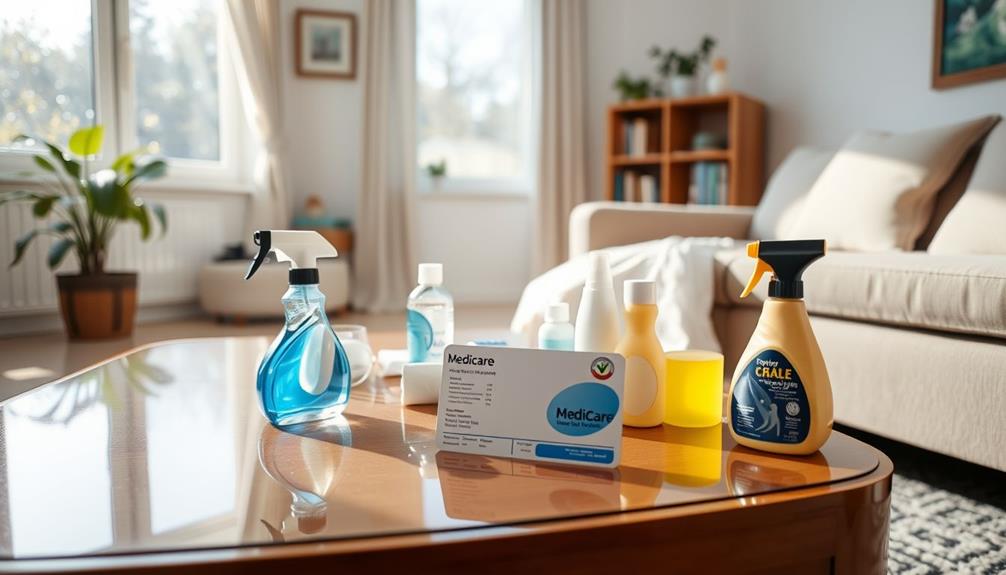Medicare does not cover home cleaning services, so you will need to pay for these expenses yourself. While Original Medicare does not include personal care tasks such as cleaning, some Medicare Advantage Plans may offer limited assistance based on specific health needs. A doctor’s order is required for eligible home health services, primarily skilled nursing and therapy, not for cleaning assistance. You can look into local programs, Medicaid, or community resources for potential financial aid. It is important to be aware of your options to manage costs. For more information on available assistance and strategies, refer to the following details. Consider exploring alternative options for home cleaning, such as hiring top robot vacuum services or independent cleaning professionals, as they may be more cost-effective than traditional cleaning services. Additionally, contacting local senior centers or community organizations can provide helpful information on affordable cleaning solutions for seniors. By making informed decisions and exploring available resources, you can ease the financial burden of home cleaning services.
Key Takeaways
- Medicare does not cover house cleaning services, classifying them as non-medical expenses that must be paid out-of-pocket.
- Some Medicare Advantage Plans may provide limited cleaning assistance if linked to specific health conditions.
- Eligibility for home health services requires a doctor's order and must be conducted by a Medicare-certified agency.
- Local programs, Medicaid, and community resources may offer financial assistance for cleaning services to low-income seniors.
- Understanding the costs and comparing quotes for cleaning services is essential since typical rates range from $19 to $26 per hour.
Understanding Medicare Coverage
When it comes to understanding Medicare coverage, it's important to know what services are included and what aren't. Medicare primarily covers medically necessary home health services, which focus on skilled care rather than personal assistance.
While you might think cleaning services would fall under this umbrella, they don't. They're classified as non-medical expenses and aren't covered by Original Medicare. It's also advisable to explore options for professional cleaning services that guarantee thorough cleaning standards, as detailed in what to look for in a home cleaning service.
You'll find that Medicare covers skilled nursing, physical therapy, and occupational therapy as part of home health care, but personal care services like cleaning are excluded.
If you have a Medicare Advantage plan, you might discover some plans offer limited coverage for cleaning services, but this is contingent on specific health conditions and varies by plan.
To qualify for home health services under Medicare, a doctor's order is necessary, proving the medical necessity of the care you receive.
This means that even if you need support at home, it has to be tied to your medical needs to be covered. Understanding these nuances will help you navigate your options better when considering home health services.
House Cleaning Services Overview

When it comes to house cleaning services, it's important to understand the coverage limitations under Medicare.
While some Medicare Advantage Plans might offer limited assistance, most beneficiaries will find that they've to pay for these services out-of-pocket.
Additionally, exploring options for maintaining a holistic lifestyle approach can help alleviate some stress associated with managing household tasks.
You'll also want to explore eligibility criteria for any potential support from state programs or community resources that could help with household tasks.
Coverage Limitations Explained
Despite the critical role a clean home plays in your overall well-being, Medicare doesn't cover house cleaning services. These services fall under the category of non-medical homemaker services, which Medicare classifies as not medically necessary. This means you'll have to pay for cleaning assistance out of pocket.
Original Medicare explicitly excludes personal care services like shopping, cleaning, and laundry, leaving beneficiaries to shoulder these expenses. Understanding financial aspects of support during challenging times, such as divorce financial planning, can help you manage costs effectively.
While some Medicare Advantage Plans may offer limited coverage for certain cleaning services, this is often contingent on your individual health conditions and the specifics of your plan. It's important to check with your plan for any potential options, as coverage limitations can vary considerably.
If you're unable to clean due to health reasons, know that medical necessity doesn't change Medicare's stance on this issue. Even if you have a home health aide or access to a home health agency, they typically won't provide cleaning services.
Understanding these limitations can help you better plan for managing household tasks and budgeting for necessary support. Be proactive in exploring your options to guarantee your living space remains safe and comfortable.
Eligibility Criteria Overview
Understanding the eligibility criteria for home cleaning services is essential for anyone traversing the complexities of Medicare coverage. Unfortunately, Medicare doesn't cover house cleaning services, as they're deemed non-medical homemaker services. That means you'll have to pay for them out of pocket.
It's crucial to recognize that just as vegans often seek alternatives to traditional products, you may need to explore various options for cleaning assistance, which might require doing some research into vegan-friendly alternatives.
When it comes to home health care services, eligibility requirements are strict. Here are three key points to bear in mind:
- A doctor's order is necessary for any home health care services.
- Services must be performed by a Medicare-certified agency.
- You must be considered homebound to qualify for any coverage.
While some Medicare Advantage plans may offer limited coverage for cleaning services, it's usually only if they're directly related to a medical condition. However, these options vary greatly by plan and individual circumstances.
Remember, Original Medicare doesn't recognize assistance with household tasks like cleaning as medically necessary, regardless of your health status.
If you're struggling to afford cleaning services, explore alternative assistance options, such as Medicaid, local government programs, or community resources, which might provide the support you need.
Medicare Advantage Plans Explained

What makes Medicare Advantage Plans an appealing choice for many beneficiaries? Medicare Advantage (MA) plans, also known as Part C, provide an alternative to Original Medicare by covering both Part A and Part B services. Offered by licensed health insurance companies, these plans often include additional benefits that Original Medicare doesn't, such as vision and dental care. This variety can make a significant difference in your overall healthcare experience.
Additionally, as the demand for extensive care options grows, many MA plans are expanding their offerings to include services that enhance overall well-being, such as support for AI ethical oversight in health technology. While Original Medicare doesn't cover home cleaning or homemaker services, some MA plans might offer limited cleaning services, particularly if they relate to specific home health needs. For instance, if you have asthma, certain plans may include air filtration services to improve your living conditions.
Since coverage options can vary widely between plans, it's vital to compare different Medicare Advantage offerings in your area. Keep in mind that you'll need to pay your Medicare Part B premium along with any specific premiums for your chosen plan, especially during designated enrollment periods. Understanding these details guarantees you make an informed choice that best fits your health and lifestyle needs.
Covered Home Health Services

When you need home health services, it's crucial to know what Medicare covers. Understanding these details can markedly impact your care and finances. Here's what Medicare may cover regarding home health:
1. Skilled nursing care – If you need specialized medical attention, this can be a game-changer for your recovery.
Additionally, knowing how to navigate emotional dynamics can help you maintain a supportive environment during recovery, especially if you're dealing with a loved one who may have BPD push-pull dynamics.
2. Physical and occupational therapy – These therapies can help you regain strength and independence, improving your quality of life.
3. Intermittent home health aide care – While this is limited to 8 hours daily and 28 hours weekly, it provides crucial support when you need it most.
To be eligible for these services, a doctor must order them, and they've to be provided by a Medicare-certified agency.
Keep in mind that custodial care and non-medical services like cleaning or shopping aren't covered by Medicare. If you require medical equipment, you'll need to meet the Part B deductible and may have to pay 20% of the Medicare-approved amount afterward.
Knowing what's covered by Medicare can empower you to make informed decisions about your home health care services.
Eligibility for Home Health Care

To access home health care services covered by Medicare, you'll need to meet specific eligibility criteria. First, you must demonstrate homebound status, meaning leaving your home requires considerable effort due to your health condition. Occasional trips outside won't disqualify you, but you'll need a doctor's verification to confirm the medical necessity of the services you require.
Additionally, understanding your emotional well-being during this process can be beneficial, as the role of self-awareness in forming healthy relationships often parallels the importance of addressing your overall health needs.
Additionally, the services must be provided by a Medicare-certified agency to qualify under Medicare Part A and/or Part B. This guarantees that the care you receive meets the standards set by Medicare.
It's important to note that eligibility for home health care isn't solely based on your diagnosis; it's about how that diagnosis impacts your ability to function safely at home. If you qualify, you won't face out-of-pocket costs for the covered services, making it a beneficial option for many individuals.
Understanding these criteria helps you navigate the process of securing the care you need. If you think you may be eligible, consult with your healthcare provider to discuss your specific situation and verify you're on the right path to receiving home health care coverage.
Costs Associated With Home Cleaning

When considering home cleaning services, you may face out-of-pocket expenses since Medicare doesn't cover these costs.
Understanding the importance of support services for caregivers can help you find resources that may alleviate some of these financial burdens.
Fortunately, financial assistance programs might be available in your area to help ease the burden.
Understanding your options can make a significant difference in managing your cleaning expenses.
Out-of-Pocket Expenses
How much should you expect to pay for home cleaning services? Out-of-pocket expenses for these services can range from $19 to $26 per hour, depending on your location and the specific type of cleaning you need. Since Medicare doesn't cover house cleaning costs, you'll need to budget for these expenses yourself.
To guarantee you're getting the best value, consider using apps that help you find deals on service providers, which can be a smart way to maximize savings on everyday purchases.
When considering cleaning services, keep in mind:
- Hourly Rates: Rates can vary widely, so getting multiple quotes is vital.
- Direct Hiring Risks: Hiring cleaners directly may save money, but you could face liability issues without insurance.
- Additional Tasks: Specific requests can lead to extra charges, affecting your overall budget.
While some state programs or non-profit organizations may offer financial assistance for household tasks, eligibility assessments are usually required, and there's no guarantee you'll qualify.
This makes it important to plan for your out-of-pocket expenses in advance. By understanding the potential costs associated with cleaning services, you can make informed decisions and maintain a clean home without unexpected financial strain.
Financial Assistance Programs
Finding financial assistance for home cleaning services can ease the burden of out-of-pocket costs, especially for those who may struggle to afford private help. Various financial assistance programs exist, including local government subsidies and non-profit organizations, specifically tailored for low-income seniors. These programs can greatly reduce the expense of cleaning services, which typically range from $19 to $26 per hour.
Additionally, exploring payment solutions for non-profits can help organizations offer essential services to seniors in need.
If you're eligible, Medicaid may offer coverage for personal care services that include some household tasks, depending on your state's regulations. Additionally, community resources and volunteer groups often provide free or low-cost cleaning assistance, making it easier for seniors to maintain a clean home without breaking the bank.
Moreover, if you have long-term care insurance, check your policy. Many of these policies include provisions for household help, which can give you access to more financial support for necessary cleaning services not covered by Medicare.
Alternative Financial Assistance Options

Exploring alternative financial assistance options for home cleaning services can greatly ease the burden on seniors and their families. While Medicare typically doesn't cover these services, several alternatives can help you secure support.
Here are three options to evaluate:
- Medicaid: Depending on state regulations, Medicaid may cover personal care services, including assistance with household tasks. Check your eligibility and local programs.
- Long-term care insurance: If you have a long-term care insurance policy, review it carefully. Many policies include coverage for household help, providing an essential financial resource.
- Community resources: Look into non-profit organizations and local community resources that offer volunteer-based assistance for seniors. These services can greatly reduce your financial burden.
Don't overlook the help of family members. Often, they can offer unpaid assistance with cleaning and household chores, making a big difference in your quality of life without adding financial strain.
Resources for Medicare Beneficiaries

Steering through the resources available for Medicare beneficiaries can be essential for ensuring you receive the home health care services you need. Medicare provides a wealth of information through its official website and the customer support line at 1-800-MEDICARE. Here, you can find detailed resources about your home health care options and how they fit into your care plan.
To locate home health service providers in your area, use the Medicare.gov tool that allows you to search by location and service type. This can help you identify the best agencies suited to your needs.
Additionally, Medicare's Quality of Patient Care Star Ratings system enables you to evaluate and compare the quality of different home health agencies, ensuring you make informed choices.
If you have concerns about the quality of care you receive, Medicare also offers resources for filing complaints, giving you a direct avenue to address any issues.
Educational articles and expert resources are readily available to enhance your understanding of home health services, allowing you to navigate your care plan with confidence.
Don't hesitate to reach out to your insurance company for more personalized assistance, too.
Frequently Asked Questions
Will Medicare Pay for a Housekeeper?
Think of Medicare as a strict gatekeeper, letting only certain services through.
When it comes to hiring a housekeeper, it won't open the door. Medicare doesn't cover housecleaning, treating it as a personal task rather than a medical necessity.
You might find some Medicare Advantage plans offering limited coverage tied to specific health conditions, but it's not guaranteed.
If you need help, consider exploring Medicaid or local resources for assistance.
What Are the 6 Things Medicare Doesn't Cover?
Medicare doesn't cover several important services that you might need.
First, it excludes routine dental care and vision services.
Second, it won't pay for hearing aids or exams.
Third, long-term care, like nursing home custodial care, isn't covered.
Fourth, Medicare doesn't cover non-medical services, such as housekeeping or shopping help.
Fifth, it doesn't provide coverage for meal delivery services.
Does Medicare Pay for a Home Assistant?
Think of Medicare like a gatekeeper; it only lets in medically necessary services.
When it comes to home assistants, you won't find coverage. Medicare doesn't pay for non-medical help like cleaning or laundry, leaving you to cover those costs yourself.
If you have a Medicare Advantage plan, there might be some limited support related to medical conditions, but that varies by plan.
Which of the Following Is a Medicare Requirement to Qualify for Home Health Care?
To qualify for home health care under Medicare, you must meet specific requirements.
First, you need to be considered homebound, meaning you struggle to leave home without help. A doctor has to certify that you need these services, confirming it's part of your care plan.
Additionally, the services must be provided by a Medicare-certified agency, and they should include skilled nursing or therapy, not just personal or homemaker care.
Conclusion
In maneuvering Medicare's coverage for home cleaning services, it's essential to remember that while your health is a priority, your living environment matters too. Imagine the relief of coming home to a clean space, free from the burdens of upkeep. Though Medicare may not cover these services directly, exploring alternative financial assistance options can lighten your load. Don't underestimate the impact a tidy home can have on your well-being—after all, a clean space can lead to a clearer mind.









